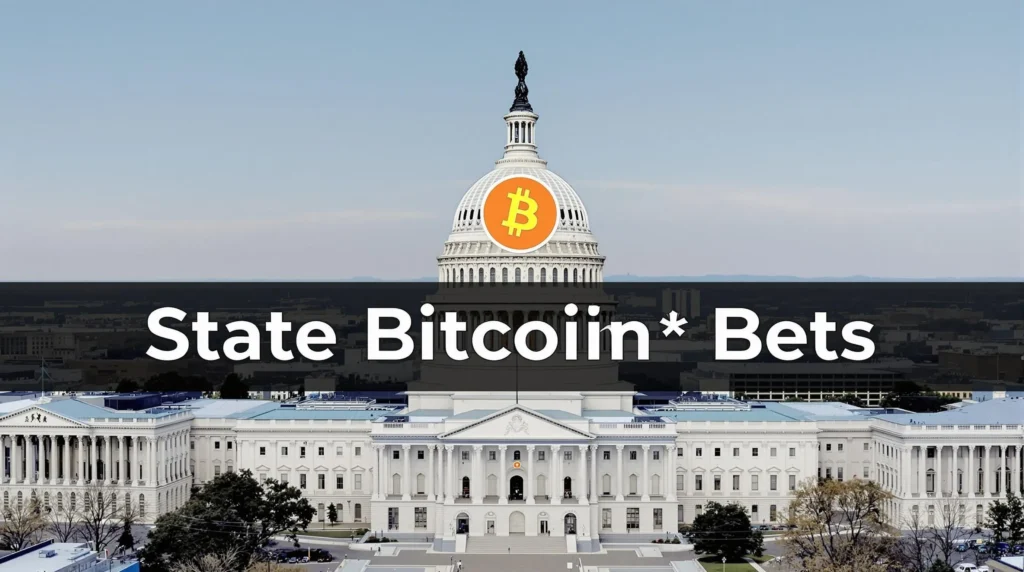Unveiling: 12 US States’ Bold $330M Bitcoin Bet on MicroStrategy – Are Taxpayer Funds at Risk?

Hold onto your hats, crypto enthusiasts! A recent analyst report has dropped a bombshell revelation: a staggering 12 US states have collectively invested around $330 million in MicroStrategy (MSTR) stock. Yes, you read that right! State governments, the custodians of taxpayer money, are indirectly dipping their toes into the Bitcoin waters through investments in Michael Saylor’s company. But what does this mean for the future of Bitcoin and the financial landscape? Let’s dive deep into this fascinating development.
Unpacking the $330 Million State Investments in MicroStrategy
Julian Fahrer, a keen-eyed Bitcoin analyst, unearthed this intriguing data, highlighting the growing intersection between traditional finance and the digital asset realm. It appears that various state retirement funds and other government investment vehicles have accumulated shares in MicroStrategy, a company renowned for its aggressive Bitcoin strategy. MicroStrategy, under the leadership of the vocal Bitcoin proponent Michael Saylor, has made headlines by holding a significant amount of Bitcoin on its balance sheet. Investing in MSTR stock is, in essence, a proxy bet on Bitcoin itself.
According to Fahrer’s analysis, these state investments are not trivial. Collectively, they represent a substantial sum, indicating a quiet but significant exposure of public funds to the volatile world of cryptocurrency. Let’s break down the key highlights:
- Total Investment: Approximately $330 million across 12 US states.
- Investment Vehicle: Primarily through state retirement funds and potentially other government investment portfolios.
- Investment Target: MicroStrategy (MSTR) stock, a publicly traded company heavily invested in Bitcoin.
- Analyst Insight: Data revealed by Bitcoin analyst Julian Fahrer.
California Leads the Charge: A $150 Million Bitcoin Stake?
The report reveals a particularly interesting detail: California stands out as the state with the largest investment. Fahrer indicates that the Golden State’s retirement funds hold over $150 million in MicroStrategy stock. That’s nearly half of the total US states‘ investment! California, known for its tech-forward approach and large economy, seems to be inadvertently taking a significant position in the Bitcoin ecosystem through this indirect route.
Why is California’s involvement particularly noteworthy? Consider these points:
- Economic Powerhouse: California’s economy is massive, and its investment decisions carry significant weight.
- Tech Hub: As the home of Silicon Valley, California is at the forefront of technological innovation, including blockchain and cryptocurrency.
- Retirement Funds: State retirement funds are crucial for the financial security of public sector employees, making investment choices highly scrutinized.
Why are States Investing in Saylor’s Strategy? Unpacking the Motivations
The question on everyone’s mind is: why are these US states investing in MicroStrategy, effectively backing Michael Saylor’s Bitcoin strategy? It’s unlikely that state investment managers are explicitly targeting Bitcoin exposure. Instead, the investment in MSTR stock is more likely a byproduct of broader investment strategies and portfolio diversification. Here are some potential reasons:
- Index Tracking: State pension funds often invest in broad market indexes like the Russell 2000 or S&P 500. As MicroStrategy is included in some of these indexes, passive investment strategies would naturally lead to the acquisition of MSTR shares.
- Diversification: Investment portfolios aim for diversification across different asset classes and sectors. Technology stocks, in general, are a common component of diversified portfolios, and MicroStrategy falls under this category.
- Growth Potential: Investment managers are constantly seeking growth opportunities. While potentially risky, stocks with high growth potential can enhance portfolio returns. Some fund managers may view MicroStrategy, linked to the potentially appreciating asset Bitcoin, as offering such growth potential.
It’s crucial to remember that state investment decisions are typically guided by long-term financial goals and fiduciary duties to beneficiaries. Directly investing in volatile assets like Bitcoin might be considered too risky for many public funds. However, indirect exposure through publicly traded companies like MicroStrategy might be seen as a more palatable approach.
The Risks and Rewards of State-Backed Bitcoin Exposure
This revelation of state investments in MicroStrategy opens up a crucial discussion about the risks and rewards associated with this indirect exposure to Bitcoin. While some may see it as a forward-thinking move, others might raise concerns about the appropriateness of using public funds to back a volatile asset like Bitcoin, even indirectly.
Potential Rewards:
- Increased Returns: If Bitcoin’s price continues to appreciate, as many proponents believe, these state investments in MSTR could yield significant returns, benefiting state pension funds and ultimately taxpayers.
- Diversification Benefits: Exposure to alternative assets like Bitcoin can potentially enhance portfolio diversification and reduce overall risk in the long run, depending on correlation with other assets.
- Future-Proofing: Embracing innovative technologies and asset classes can position states for future economic growth and technological advancements.
Potential Risks:
- Volatility: Bitcoin is notoriously volatile. A significant downturn in the cryptocurrency market could negatively impact the value of MSTR stock and, consequently, state investment portfolios.
- Regulatory Uncertainty: The regulatory landscape for cryptocurrencies is still evolving. Unforeseen regulatory changes could impact the value and legality of Bitcoin and related investments.
- Public Scrutiny: Using public funds to invest, even indirectly, in a controversial and volatile asset like Bitcoin could attract public criticism and political scrutiny, especially if investments perform poorly.
Is Your State Among the Bitcoin Backers? Actionable Insights
The analyst’s report highlights 12 US states with investments in MicroStrategy. While the specific states are not explicitly named in the provided snippet, the fact that California is mentioned suggests that other large states with significant pension funds might also be on the list.
Actionable Insights for Readers:
- Check Your State Pension Fund: If you are a public sector employee or taxpayer in the US, you can investigate the investment holdings of your state’s retirement funds. Publicly available reports often detail the stock holdings of these funds.
- Engage with Your Representatives: If you have concerns or opinions about state investments in Bitcoin-related assets, consider contacting your state representatives and expressing your views.
- Stay Informed: Follow cryptocurrency news and market analysis to stay updated on the developments in the digital asset space and their potential impact on traditional finance and public institutions.
The Bottom Line: A Quiet Revolution in State Finance?
The revelation that 12 US states hold a substantial $330 million stake in MicroStrategy is a noteworthy development in the ongoing integration of cryptocurrency into mainstream finance. While these state investments are likely indirect and unintentional, they nonetheless represent a significant exposure of public funds to Michael Saylor’s Bitcoin strategy and the broader Bitcoin market. Whether this is a prudent move or a risky gamble remains to be seen. However, it undeniably signals a growing acceptance and, perhaps, even an unwitting embrace of Bitcoin by traditional financial institutions and, surprisingly, state governments. As the cryptocurrency landscape continues to evolve, it will be crucial to monitor these trends and understand the implications for both public finance and the future of money.









